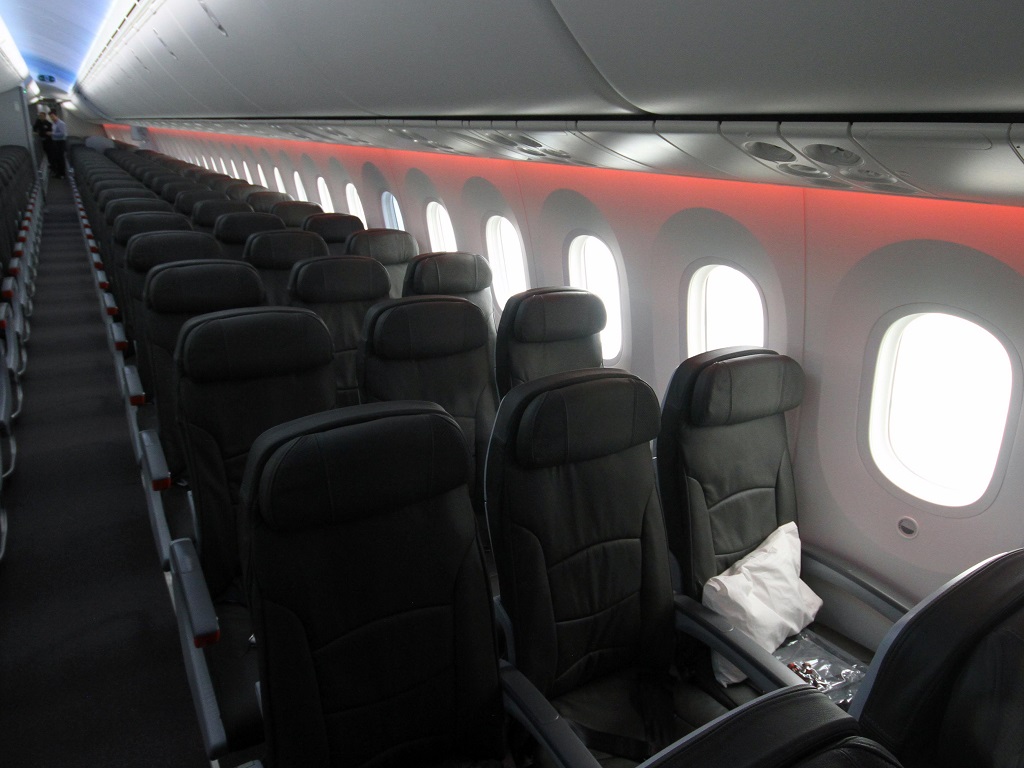As the US Federal Aviation Authority moves to examine spacing between airline seats, AirlineRatings.com has uncovered a 2001 UK study which warned about the safety consequences of shrinking airline seating.
The UK study “Anthropometric Study to Update Minimum Aircraft Seating Standards” was initiated by the Joint Aviation Authorities (JAA) under United Kingdom (UK) Civil Aviation Authority (CAA) funding and found that many economy-class passengers do not have enough space to assume the correct “brace” position for emergency landing. It also found the seats themselves are obstacles to quick emergency evacuation of the cabin.
The study’s findings into the distance between seats (seat pitch) adds significant weight to a US Court ruling forcing the US Federal Aviation Authority to look at minimum standards for seat pitch and width on commercial airliners.
The United States Court of Appeals For the District of Columbia, considered by some to be the second most influential court in the land, was responding to a petition by lobby group Flyers Rights.
The court said the consumer group contended narrower seats and closer spacing were “endangering the safety, health, and comfort of airline passengers.”
“This is the Case of the Incredible Shrinking Airline Seat,” wrote Judge Millett. “As many have no doubt noticed, aircraft seats and the spacing between them have been getting smaller and smaller, while American passengers have been growing in size.”
The fundamental rule the FAA uses before certifying an aircraft to carry passengers is the ability to evacuate all passengers within 90 seconds, in low visibility with half the exits blocked.
However, the UK study conducted by ICE Ergonomics Ltd found that cramped seating can trap and trip passengers during an emergency evacuation and it found that more space was needed for today’s overweight and taller passengers.
The study was safety-focused and did not comment on the comfort of passengers but it found that “economy-class passengers are so tightly packed together that they cannot assume a correct brace position for emergency landing”.
The study concluded that the minimum dimensions need to be expanded by at least 3 inches (7.62cm) in terms of seat pitch from about 28 inches to 31 inches. The report also said that “the current widths of typical economy class seats, and in particular the distances between the two armrests, are totally inadequate to accommodate larger bodied passengers.”
Most low-cost airlines have seat pitches between 28 and 30 inches, while traditional carriers typically offer 31 to 33 inches spacing.
Many low-cost airlines now offer extra spacing for a small cost – but find that thrifty passengers are reluctant to spend the extra required.
The CAA recommended increases in pitch and width but that went into limbo after the responsibility was taken over in September 2003 by the European Aviation Safety Agency (EASA).
Airlines – and their passengers – have been squeezed by the constant demand for cheaper fares and the increased height and weight of the population.
In 2000, it was estimated by the American Journal of Preventative Medicine that airlines in the US had to use an additional 300 million gallons of fuel to carry the increasing weight of passengers.
More than one-third (36.5 per cent) of U.S. adults are now classified as obese, something that prompted the FAA on August 12, 2005, to increase the weighting of passengers.
The FAA lifted the male passenger with carry-on weighing from 185 to 200lbs for summer and 190 to 205lbs for winter.
The averages for women – who are also weighing in heavier – increased from 145 to 179lbs in summer and 150 to 184lbs in winter.
But this is not just a US problem. Downunder, The Australian and New Zealand Obesity Society has shown that the image of the lean athletic bronzed Aussie is a myth, citing a 2014-15 Australian Bureau of Statistics figures showing that 63.4 per cent of Australian adults were overweight or obese (11.2 million people). This is a big jump from the 56.3 per cent in 1995.
Height is the other issue. According to R W Howard’s “Interrelating Broad Population Trends”, the world’s population has grown almost 3 inches (7cm) from 1945 to 2000 because of better nutrition and health.
According to research led by scientists from Imperial College London, the average human height has gone up in industrialized countries over the past 100 years ranging from the United Kingdom to the United States to Japan, with gains of up to 10 centimeters (4 inches).
But the gains are uneven.
The research found that South Korean women and Iranian men have the biggest increases in height over the past 100 years. Iranian men have increased by an average of 6.4 inches (16.5cm), and South Korean women by 7.95 inches (20.2cm).
The evacuation of aircraft has also come under close scrutiny for another reason – the insistence of passengers to take their carry-on baggage with them in an emergency.
Airfares would have to triple if aviation regulators were to re-certify aircraft to the reality of recent chaotic passenger evacuations that are taking up to 6 minutes – not 90 seconds.
Passengers are risking their lives, and those of fellow passengers, with the obsession of taking cabin baggage with them in an emergency.
If regulators, for instance, were to recertify the long-range Boeing 777 to the reality of what actually happens, the 550-exit limit aircraft would have to be recertified to just 183 passengers – half its typical load.
But for smaller aircraft such as the widely used A320 – and Boeing 737 – which has an exit limit of 195 and a typical configuration of 180 mostly economy passengers the impact would be devastating with a new limit of just 65.
That would mean a tripling of airfares to make the aircraft economically viable.
And authorities are already stirring. Last year, after a British Airways incident at Las Vegas the highly respected British Civil Aviation Authority issued a blunt warning to its airlines: Stop passengers taking their hand luggage off with them in an emergency evacuation.
























